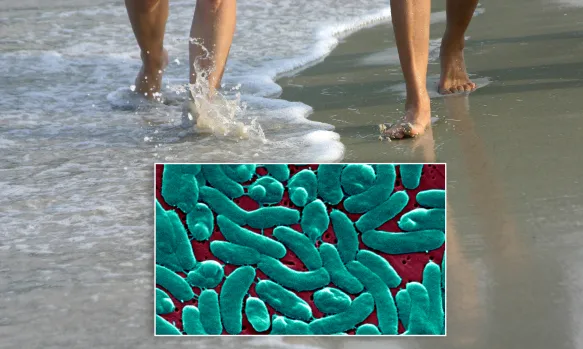Flesh Eating Bacteria in New Jersey: Myths, Facts, and How to Protect Yourself

Flesh Eating Bacteria in New Jersey is a phrase that causes alarm, especially during the warmer months when awareness spikes. Whether sparked by news reports of severe infections or sensational headlines, the idea that bacteria in our coastal waters could literally eat human flesh is terrifying. But what’s fact, what’s myth, and what actionable steps can residents take? This article dives into the science behind necrotizing infections, clarifies regional risk, and offers practical prevention tips.
1. What Are “Flesh-Eating Bacteria”?
The term “flesh‑eating bacteria” refers to bacteria that cause necrotizing fasciitis, a rare but serious condition characterized by rapid destruction of skin, fat, and muscle tissue. Key bacterial culprits include:
- Group A Streptococcus (GAS) – also called Streptococcus pyogenes, a common cause of necrotizing soft tissue infections.
- Vibrio vulnificus – a marine bacterium that causes severe wound infections and septicemia.
Although both are capable of causing flesh‑eating disease, they occupy different ecological niches and have distinct modes of transmission.
2. Why Focus on New Jersey?
The New Jersey shoreline—brackish and saltwater bodies like Delaware Bay—has become a concern due to reports of Vibrio vulnificus infections. A 2019 study out of Cooper University Hospital recorded five cases of V. vulnificus wound infections linked to Delaware Bay activities, a notable increase from prior years.
A particularly dramatic incident occurred in 2018 when a South Jersey resident, Angel Perez, contracted an aggressive Vibrio infection from a scratch while crabbing near the Maurice River. The infection rapidly led to gangrene in his legs, requiring intensive care and limb-sparing surgery.
Such incidents, alongside reports of nearby occurrences in Delaware Bay, have heightened awareness in New Jersey—though it’s important to stress that confirmed cases remain extremely rare.
Related Article: Flesh Eating Bacteria Kills 5 in Florida: How to Stay Safe This Summer
3. Distinguishing Myth from Reality
Myth 1: “You’ll Get Flesh‑Eating Bacteria Just by Swimming.”
Reality: Not true. You must have an open wound, cut, or abrasion, and that wound must be exposed to Vibrio‑contaminated water (salt or brackish). Infection usually begins at the wound site, not through intact skin.
Myth 2: “Flesh‑Eating Bacteria Are Common in NJ Tap Water or Freshwater.”
Reality: Vibrio vulnificus thrives in warm, saline and brackish water—estuaries, tidal rivers—but not in treated tap or freshwater. Group A Strep, meanwhile, is transmitted via skin contact in various settings, but isn’t tied to coastal exposure.
Myth 3: “Anyone Is Equally at Risk.”
Reality: No. People with immune compromise (e.g. liver disease, diabetes, cancer, HIV), chronic conditions, older age, or those on certain medications are significantly more vulnerable.
4. Flesh Eating Bacteria in New Jersey: Key Facts
A. Vibrio vulnificus
- Habitat: Warm coastal and brackish waters, especially in summer (May–October).
- Infections: Primarily wound infections leading to cellulitis, necrotizing fasciitis, and severe bloodstream infections. Also causes foodborne illness via raw shellfish.
- Severity: High mortality—wound infections lead to ~25% case fatality; septicemia up to 50%, often within 48 hours without rapid treatment.
- NJ Cases: Five wound infections in 2017–18 tied to Delaware Bay; individual fatalities reported.
B. Group A Streptococcus (GAS)
- Prevalence: Nationwide; causes strep throat and skin infections.
- Severe Cases: Invasive GAS can cause necrotizing fasciitis and streptococcal toxic shock syndrome. In the US, ~700–1,150 cases of necrotizing fasciitis per year; ~14,000–25,000 invasive infections including GAS.
- NJ Surveillance: Invasive GAS reporting has been mandatory since 1995. Highest risk groups include the elderly, immune-compromised, diabetes patients, drug users, etc.
5. Why Are Cases Rising Locally?
Warmer Waters
Ocean and bay water temperatures along the East Coast have steadily warmed due to climate change. Vibrio vulnificus now flourishes further north than historically, with infections appearing earlier and lasting longer in the season.
Popular Recreational Activities
Crabbing, fishing, boating, and kayaking—especially with minor cuts—can expose individuals to contaminated waters. With more people enjoying the coast, the odds of rare exposures rise.
Vulnerable Populations
More residents with conditions like diabetes, liver disease, or on immunosuppression live near the shore, elevating community risk profiles. However, with good awareness and care, serious outcomes remain rare.
6. Signs & Symptoms to Watch For
Vibrio vulnificus Wound Infection
- Within 24–48 hours of wound exposure: redness, severe pain, swelling
- Progression: blistering, discoloration, necrosis, fever, chills, sepsis
Immediate medical attention is required if wounds rapidly worsen after water exposure.
Necrotizing Fasciitis (From GAS or Vibrio)
- Early symptoms (within hours): red or swollen skin area, severe pain (often out of proportion to appearance), fever
- Advanced signs: blisters, blackened tissue, pus, dizziness, nausea, shock
Diagnosis and urgent treatment—surgical debridement and IV antibiotics—are critical. Mortality remains high (20–35% GAS, higher with Vibrio).
7. Prevention Strategies in New Jersey
1. Wound Protection
- Avoid entering salt/brackish water when you have open cuts or abrasions.
- Use waterproof bandages or liquid sealants for minor wounds during activities like fishing or boating. Change daily.
- After water exposure, clean wounds with soap and fresh water and apply fresh dressing. For deeper wounds, seek medical care promptly.
2. Seafood Safety
- Avoid raw or undercooked oysters and shellfish. Cook seafood thoroughly.
- When handling raw seafood, wash hands and surfaces meticulously. Cover any hand wounds before handling.
3. Know Your Risk Profile
- Individuals with chronic liver disease, diabetes, HIV, cancer, etc., should practice greater caution. Boosting immune function via health management is crucial.
4. Early Recognition & Medical Response
- Seek medical evaluation for:
- Rapidly worsening wounds after water or seafood contact
- Redness widening beyond the injury, disproportionate pain, fever, swelling
- Blisters, necrosis, or signs of systemic illness
- Physicians should consider Vibrio infection early and begin empiric antibiotics, wound cultures, imaging, and surgical consultation.
5. Community Awareness
- Local health departments and coastal authorities should issue seasonal warnings during warm-weather periods. Educational signage at boat launches, marinas, and beaches can reduce risk.
8. What to Do If You Suspect Infection
Step-by-step Response:
- Don’t wait – time is critical.
- Go to emergency or urgent care. Notify them of water/seafood exposure.
- Medical evaluation: bathroom inspection, vital signs, labs, imaging.
- Treatment:
- IV broad‑spectrum antibiotics, often a cephalosporin plus doxycycline or ciprofloxacin for Vibrio; penicillin for GAS necrosis
- Immediate surgical debridement if necrosis is present.
- Intensive supportive care for sepsis or organ dysfunction.
- Outcome: Survival depends on prompt diagnosis and intervention. Follow-up with possible additional surgeries or rehabilitation may be necessary.
9. Understanding the Statistics
- Vibrio Infections: CDC estimates ~80,000 Vibrio illnesses annually in the US, with ~100 deaths. V. vulnificus accounts for <1% of those but ~20-50% case fatality in severe cases.
- Necrotizing Fasciitis (GAS or other): ~700–1,150 cases/year of necrotizing fasciitis; ~1,000 total NSTI cases annually across causative organisms. Mortality ~25–35% even with timely treatment.
- New Jersey: Only a handful of documented Vibrio wound cases and GAS NSTI cases each year. Incidence remains extremely low relative to population, but awareness is increasing.
10. Beyond the Shore: Wound Care at Home
Even outside marine environments, general measures help reduce all necrotizing infection risk:
- Clean and dress even small cuts or burns immediately.
- Practice hand hygiene.
- Avoid self‑treatment of serious wounds.
- For high‑risk individuals, medical advice is important if wounds show infection signs.
11. Local Resources & Reporting
- NJ Department of Health receives mandatory reports of invasive GAS and monitors necrotizing cases.
- Cape May County Health Department provides guidelines on vibriosis.
- CDC and FDA offer guidance on handling seafood and wound prevention.
The Bottom Line
Flesh Eating Bacteria in New Jersey is a genuine—though rare—health threat, especially for those with open wounds and underlying health risks. But with proper caution, knowledge, and awareness, nearly all infections can be prevented or treated successfully.
- Don’t panic: Serious cases are rare.
- Respect the water: Cover wounds, practice good hygiene, and cook seafood thoroughly.
- Stay informed: Recognize symptoms and seek prompt care if needed.
FAQs
Q1: Can I wade in mangroves or brackish water with a small cut?
A: No. Any break in the skin can be an entry point for Vibrio. Cover wounds completely or avoid such water exposures.
Q2: Are freshwater bodies safe?
A: Generally yes for Vibrio—but Group A Strep can occur in any environment via common skin contact.
Q3: Do I need to avoid beach trips entirely if diabetic or immunocompromised?
A: Not necessarily—but your risk is higher. Use precautions—full coverage for wounds, thorough cleaning before and after, and avoiding contact with raw seafood.
Q4: How fast does necrotizing fasciitis spread?
A: Very rapidly—often within hours. Key signs include severe pain beyond visible injury, rapid redness, and systemic symptoms. Immediate medical attention is vital.




